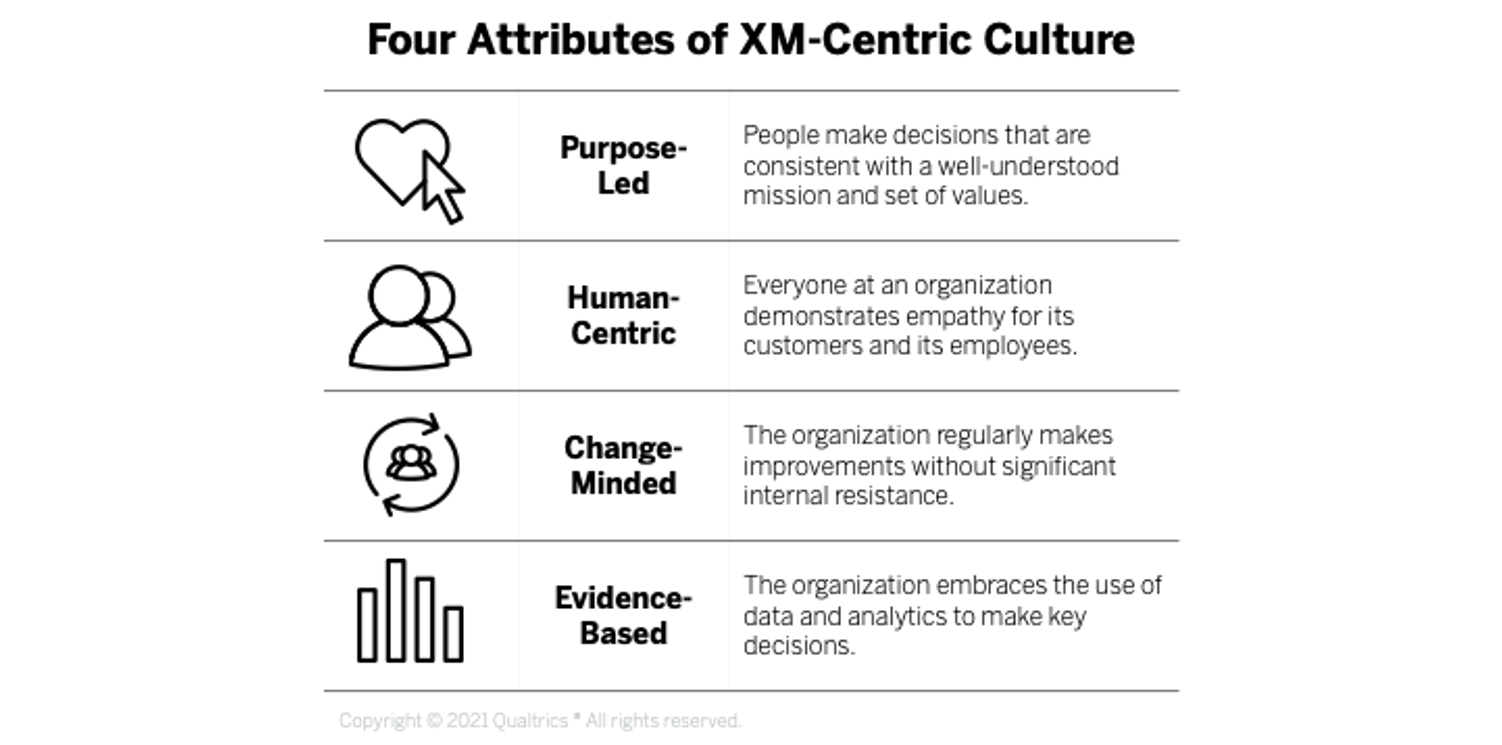Culture is one of those “things” that everyone recognizes but few can put their finger on, and even fewer understand how to influence. That’s because an organization’s culture is not static; it is constantly being co-created by the people within it.
When we consider how culture influences experience management (XM) efforts, we define it simply as the way employees across an organization think, believe, and act. In order to create an organization focused on XM, then, organizations must create and nurture XM-mindsets and clearly define, enable, and expect the behaviors that enable it.
Four Attributes of an XM-Centric Culture
While every organization’s culture is necessarily unique, there are certain consistent cultural attributes that we observe among the most XM-centric organizations.

XM-centric organizations nearly always have stated cultural values aligned to one or more of these, often in brand vision statements. But far more important than any stated values is how leaders and employees within those organizations show up, visibly, to deliver on those values in their day-to-day work.
Four Ways to Drive XM-Centric Culture Change
XM professionals must operate within the cultures of their organizations. Driving an organization toward these XM-centric mindsets and behavior patterns may seem daunting since it is both big and nebulous. After all, most XM professionals are not charged with, nor responsible for, cultural transformation. The good news is that delivering XM actually does not require long-term cultural shifts or large-scale change management. Here are four practical tactics that any XM professional can use to get started.
- Leverage existing cultural tailwinds. Nearly every organization has established firm cultural values or a formal credo. Regardless of where the organization is on its journey, there are likely to be existing values that support growth toward an XM-centric culture. XM professionals should explicitly map their XM vision and roadmap to one or more of the existing cultural values. For example, one U.S.-based mortgage lending company explains changes to their XM programs (e.g., changes to existing employee and customer surveys, shifts in their roadmap) by aligning them to their core value of “find a better way.” The changes are all designed to “find a better way,” creating internal comfort with the iteration on processes and roadmaps. This provides a powerful, cultural foundation for the decisions and proposals they present to leaders about the organization’s XM journey.
- Position stated values against cultural headwinds. XM growth involves organizational change and with change comes headwinds. In some cases, these headwinds may come in the form of influential leaders who create significant roadblocks to XM growth or old behavioral norms that are incompatible with change. In the same way that XM professionals can use existing cultural values as a tailwind, they can also position them to navigate these headwinds. For example, in one global financial services firm, the People Analytics function regularly leverages its stated cultural value “progress over perfection” to push forward when XM efforts stall due to inefficient review cycles or bureaucracy. Unsupportive people, processes, and policies are positioned against the value of progress, encouraging the XM-behavior that supports the vision.
- Capitalize on organizational shifts. There are situations when XM professionals must introduce new values, mindsets, and behavior patterns into the organization. The XM Diffusion Cycle provides a structured framework in which to do this. But timing is also critical to the success of these proposed changes. Some of the biggest XM shifts that we’ve studied occurred after major organizational shifts, including changes in senior leadership, mergers and acquisitions, and large-scale reorganizations. For example, in one international technology company, the employee and customer analytics teams timed many of their transformative XM efforts shortly after the company’s board selected a new CEO. The company already had a greater appetite for change, given the significant change in leadership, creating a much more welcome environment. Likewise, a North American telecommunications company proactively plans ahead for organizational changes and maintains a list of transformative activities and the conditions necessary for their key XM initiatives to be successful.
- Highlight and celebrate culturally impactful leaders. Leadership is critical to XM culture adoption. Another effective step is to highlight and raise the profile of leaders within the organization who possess and share XM-centric mindsets. One global auto manufacturer has created an ambassador program that regularly spotlights the local activities of leaders across the enterprise. This often appeals to people’s internal motivations and helps to influence other leaders. An American-based airline uses a similar approach, leveraging its highly competitive culture to influence leaders to get on board by observing their successful peers.
Above all, XM professionals who influence their organizations’ cultures are both patient and persistent. In nearly every organization, this cultural transformation is gradual and starts with iteratively influencing the behaviors of others in the organization.
Bottom Line: Progress is more important than perfection when it comes to driving an XM-centric culture.
Elizabeth Erkenbrack, Ph.D., is a Head of CX Solution Strategy with Qualtrics specializing in Customer Experience, Digital Experience and Culture Change
Benjamin Granger, Ph.D., XMP, is an XM Catalyst for the Qualtrics XM Institute





